Tutorials/Install KDE software/uk: Difference between revisions
(Created page with "Доступ до програми для керування пакунками openSUSE можна за допомогою вкладки <menuchoice>Комп’ютер</menuch...") |
(Created page with "[[Image:Yast-package-management-1.png|center|500px|thumb|Пошук пакунків Kate; libkate1 вже встановлено, kate позначено для встановл...") |
||
| Line 13: | Line 13: | ||
Доступ до програми для керування пакунками openSUSE можна за допомогою вкладки <menuchoice>Комп’ютер</menuchoice> меню запуску програм. Відкрийте цю вкладку і натисніть піктограму з підписом <menuchoice>Керування програмами</menuchoice>, щоб запустити програму для керування програмами. | Доступ до програми для керування пакунками openSUSE можна за допомогою вкладки <menuchoice>Комп’ютер</menuchoice> меню запуску програм. Відкрийте цю вкладку і натисніть піктограму з підписом <menuchoice>Керування програмами</menuchoice>, щоб запустити програму для керування програмами. | ||
[[Image:Yast-package-management-1.png|center|500px|thumb| | [[Image:Yast-package-management-1.png|center|500px|thumb|Пошук пакунків Kate; libkate1 вже встановлено, kate позначено для встановлення.]] | ||
Use the search field to find the package that you wish to install; you can search on the package name or the package description, and you only need to enter part of the name. You will then be presented with a list of packages matching your search. Click the selection boxes for the packages to to be installed and then click <menuchoice>Accept</menuchoice>. See [http://en.opensuse.org/Package_management this page] for more on package management and openSUSE. | Use the search field to find the package that you wish to install; you can search on the package name or the package description, and you only need to enter part of the name. You will then be presented with a list of packages matching your search. Click the selection boxes for the packages to to be installed and then click <menuchoice>Accept</menuchoice>. See [http://en.opensuse.org/Package_management this page] for more on package management and openSUSE. | ||
Revision as of 12:53, 4 March 2012
Встановлення програмного забезпечення KDE
Для встановлення програмного забезпечення KDE рекомендуємо вам скористатися засобами вашого дистрибутива. За допомогою цієї сторінки ви можете визначитися з назвою і версією вашого дистрибутива.
ось це слід копіювати до поля запрошення командного рядка без змін.
За допомогою програм для керування пакунками
openSUSE
Доступ до програми для керування пакунками openSUSE можна за допомогою вкладки меню запуску програм. Відкрийте цю вкладку і натисніть піктограму з підписом , щоб запустити програму для керування програмами.
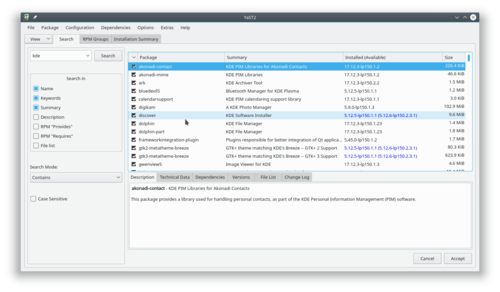
Use the search field to find the package that you wish to install; you can search on the package name or the package description, and you only need to enter part of the name. You will then be presented with a list of packages matching your search. Click the selection boxes for the packages to to be installed and then click . See this page for more on package management and openSUSE.
Крім того, для встановлення програмного забезпечення у openSUSE ви можете скористатися програмою KPackageKit.
Ubuntu/Kubuntu
In Kubuntu the default way to install software is using KPackageKit (as of Kubuntu 11.04, this may change in future releases). Most software installation is described in the KPackageKit article. Unless you have been instructed to add additional software sources, you should not need the information below.
The only real difference is in choosing sources for your software. Kubuntu is set up already with most of what you should need, but if you are instructed to add another software source then you need to go to tab to the left side of the KPackageKit window. If the software source is not already listed (see screenshot below) then you can click on towards the bottom of the window.
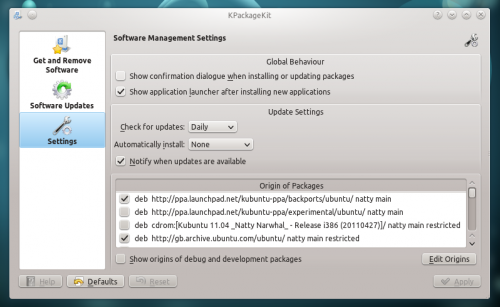
Програма попросить вас ввести пароль до облікового запису вашого користувача, а потім відкриє вікно подібне до такого:
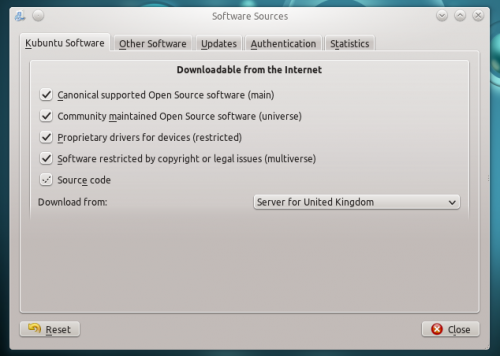
You normally do not need to change these setttings. The software sources can be added by going to the tab, where you can click on the add button and type (or copy and paste) the software source address in the dialog that opens:
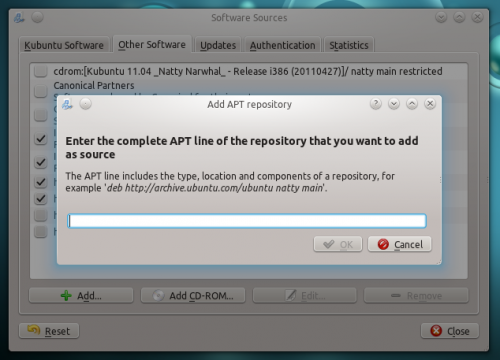
Fedora
yumex will start the graphical package manager. When you start it, the first thing it will do is check to see whether you need any updates. Usually it is best to accept all the updates. If you click on Groups above the file list you will see it re-ordered, showing how a group of packages can be installed by a single click. Look for the cursor in the left panel, touching the arrow:
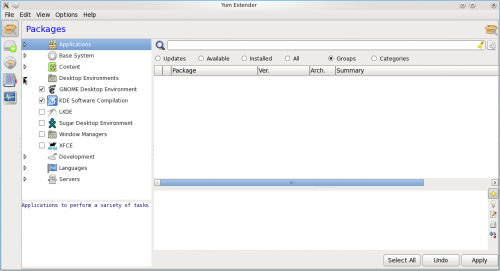
Clicking on the arrow-head rotates it,listing the package options for that group. This is where you can install the base KDE if it wasn't installed originally.
Mageia і Mandriva
KDE is the default desktop in Mageia and Mandriva. You can install KDE software using Mageia/Mandriva Control Center (mcc). Just use then go to page and choose . Standalone graphical installer can be launched from KRunner, just enter drakrpm into the input box.
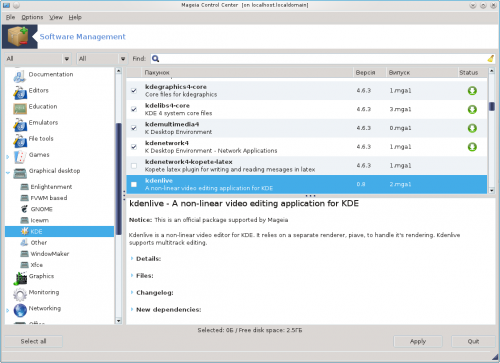
Інші дистрибутиви
Other distros will offer a package manager. You will need to find it from your menu, but once found, one of these descriptions above should have something similar to yours. If in doubt, ask on IRC and someone will help you. If you've never used IRC, here is a guide to starting to chat with other users.
За допомогою командного рядка
If you find that using a package manager is unbearably slow, you will want to use command-line installation. This is much faster, but the disadvantage is that you need to know the exact name of the package you want to install. Each system has helpful commands for searching, for instance, so try using the first word of install command below, with --help appended. As an example, yum --help will list the commands you can use for Fedora, but they are many and can be confusing at first.
openSUSE
With openSUSE you install software using zypper
for example to install KWrite you will open a console and enter
zypper in kwrite. In older installations of openSUSE, yast was used like this: yast -i kwrite. You can still use yast if you prefer.
Ubuntu
With Ubuntu Linux you install software using apt-get. For example to install KWrite you will open a console and enter
sudo apt-get install kwrite
Fedora
Fedora uses yum so to install KWrite you would open a console and type yum install kwrite If you are unsure of the name of a package, you can use yum list with wildcards to see all the packages with a word as part of the package name — for example yum list *network* will list all available packages with "network" as part of the name. Casting even wider, yum search mpeg will list all packages that either have mpeg in the name or in the description of the package.
Mageia і Mandriva
Встановити програмне забезпечення KDE за допомогою командного рядка вам допоможе програма urpmi. З іншими корисними командами можна ознайомитися на цій сторінці Вікіпедії.

